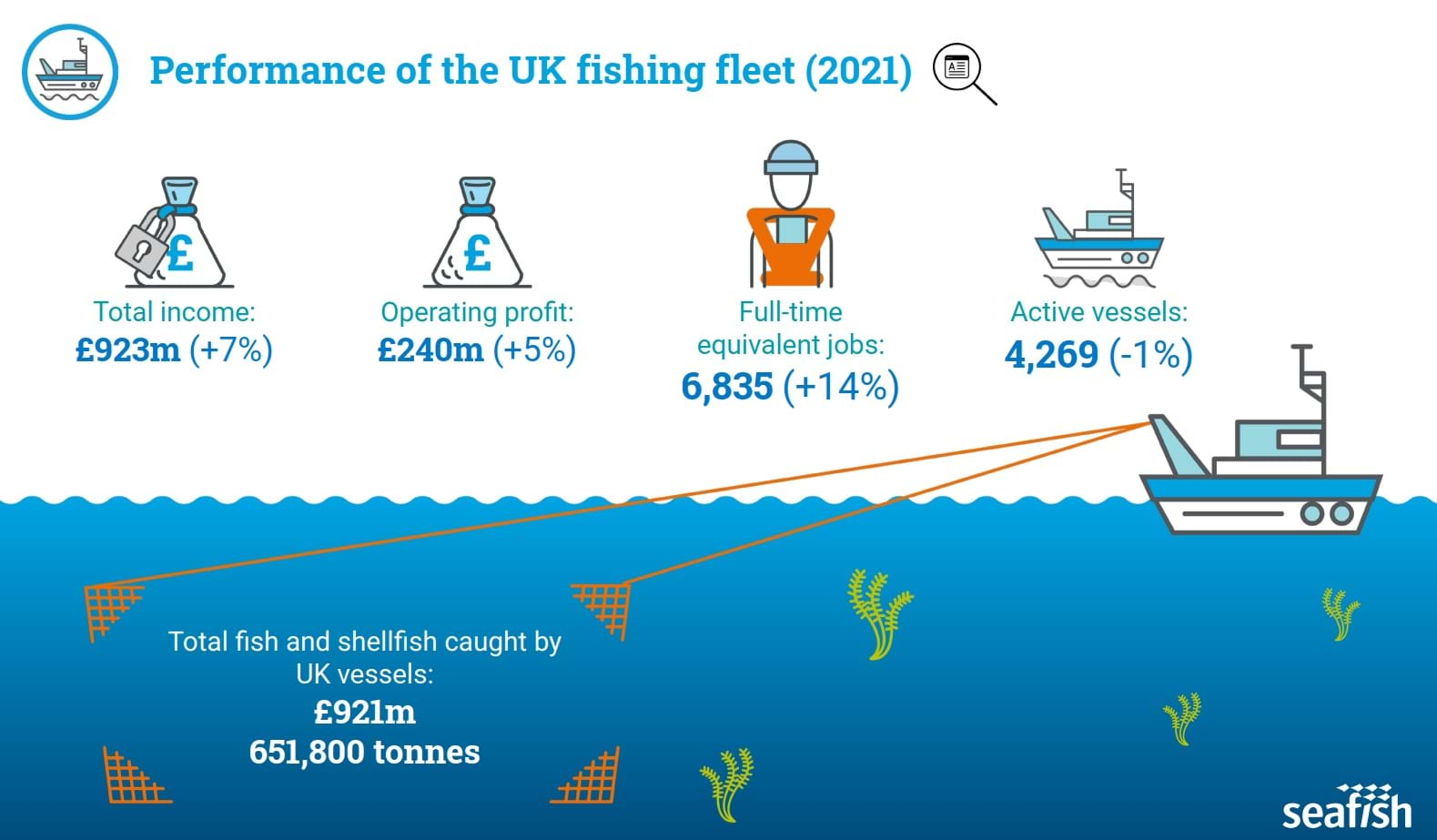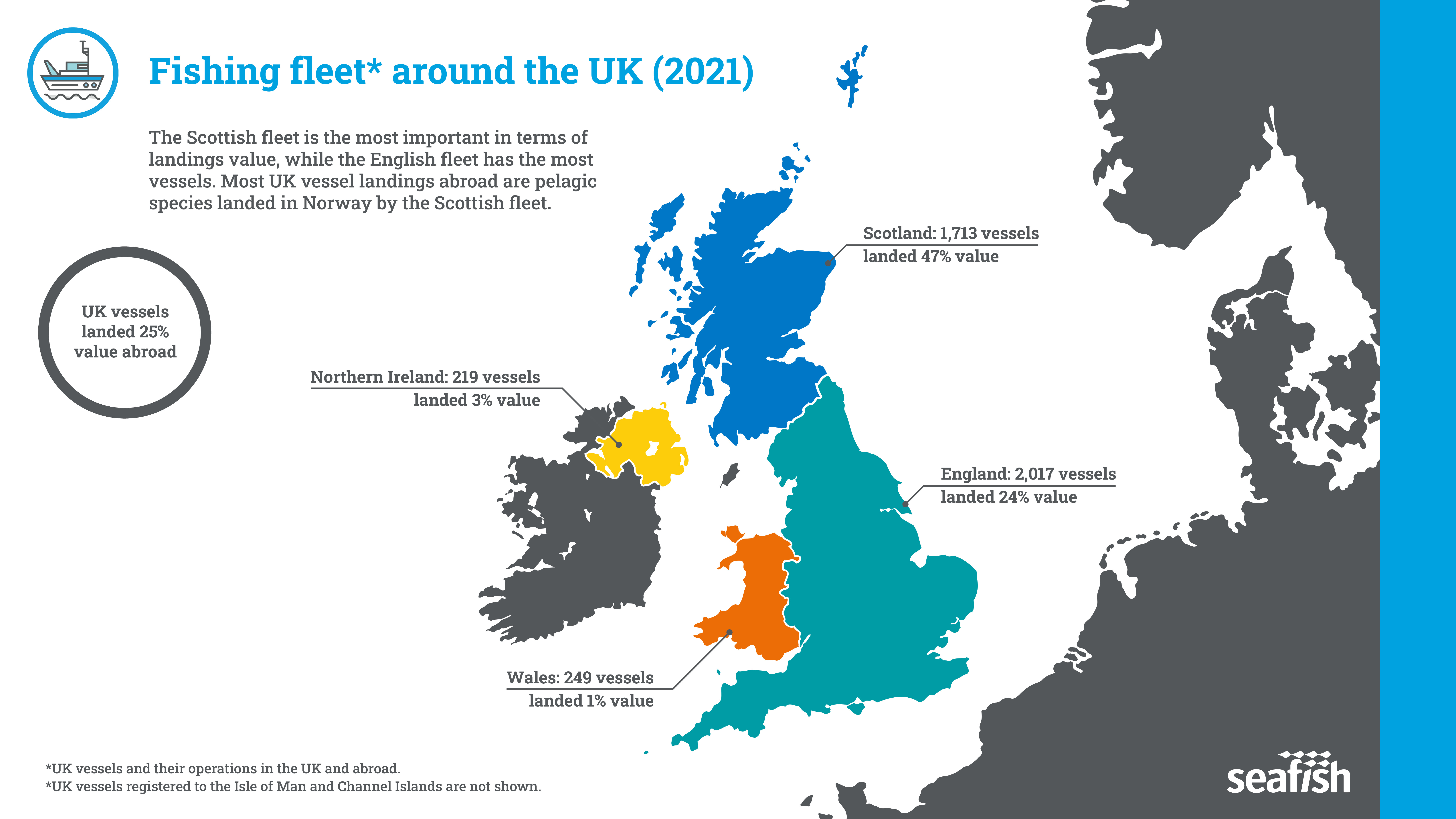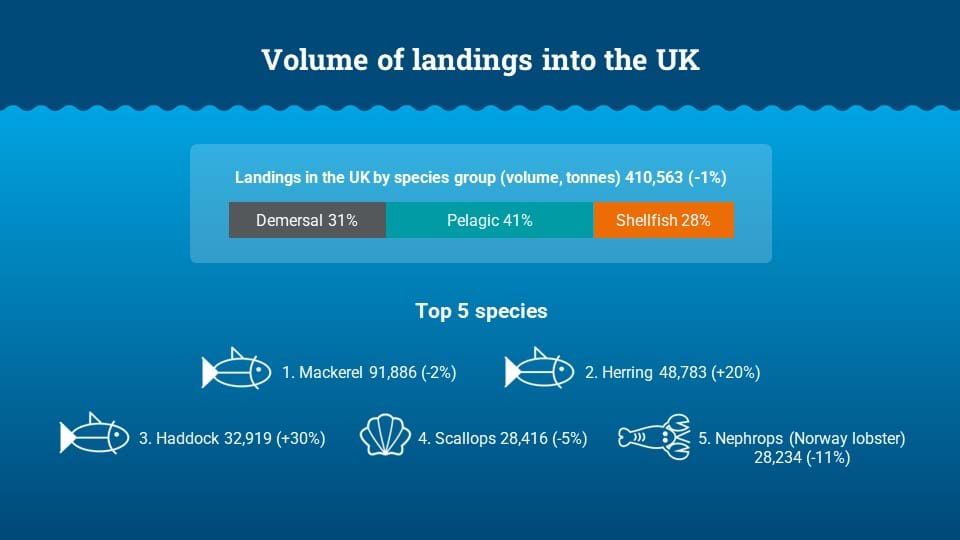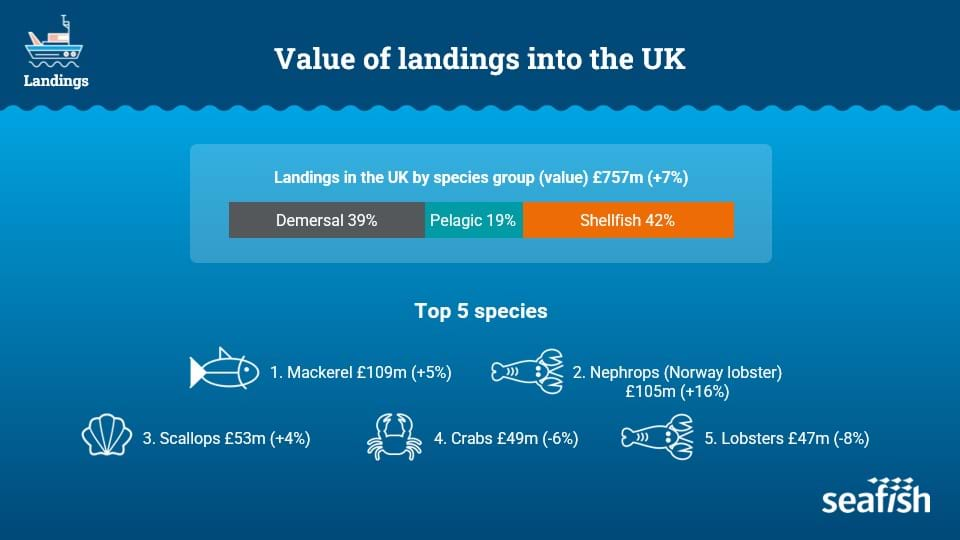Fishing data and insight
This page has information on:

In 2021 there were 4,269 active fishing vessels in the UK. Around 64% of these vessels were under 10 meters in length. There were 6,835 people working on those fishing vessels (Full Time Equivalent jobs).
In 2021 turnover of the UK fishing fleet was £923 million. Operating profit was £240 million.
Catches by the UK fishing fleet
The UK fishing fleet landed 631 thousand tonnes of fish and shellfish in 2021 in the UK and abroad. The total value of landings in 2021 was £893m, which is a 9% increase from 2020.
By weight, the top species landed by the UK fleet in the UK and abroad in 2021 were:
- Mackerel (209,000 tonnes)
- Herring (77,000 tonnes)
- Blue whiting (74,000 tonnes)
- Norway Lobster (32,000 tonnes)
- Scallops (29,000 tonnes)
By value, the top species landed by the UK fleet in the UK and abroad in 2021 were:
- Mackerel (£223 million)
- Norway Lobster (£92 million)
- Crab (£63 million)
- Monkfish (£56 million)
- Scallops (£52m)
Fishing fleet around the UK

72% of the landings by the UK fleet (by weight) were made in the UK. The Scottish fleet is the most important in terms of landings value. Peterhead and Lerwick were the main UK landing ports. The English fleet has the most vessels. UK landings abroad were mainly to ports in Norway, Denmark, the Netherlands and Ireland.
More information on the UK catching sector is available in our annual Economics in the UK Fishing Fleet report. It presents economic estimates at UK, home nation and fleet segment level for the UK fishing fleet. You can get a copy of the latest report from the link below:
To access reports from previous years, please search for 'Economics of the UK Fishing Fleet' by using the search tool at the top of this webpage.
Our latest Employment in the UK Fishing Fleet report presents a snapshot from a sample of 268 vessels and 788 workers from across the UK catching sector. This data is taken from a survey in summer 2021.
Key findings from the report are:
- Overall, most workers in the sample (64%) were from the UK. (If we extrapolate to the whole of the UK fleet it would be 80%)
- Most non-UK workers were from the Philippines, Ghana and Latvia and employed as deckhands.
- The average age of employees sampled was 40, two years younger than the average of the sample collected in 2018.
- Deckhands were the youngest workers in the sample, with an average age of 34.
- The average age of vessel owners was 50, and of hired skippers, 43.
- Most workers in the sample (99%) were male.
- The largest proportion of female workers (21%) was among ‘other’ roles (vessel owners and onshore workers, for example administering business records).
You can download a copy of the full report, which also includes data on qualifications held and remuneration methods, from the link below.
Access to Labour in fishing sector survey 2023
Between 8th and 21st of March 2023 Seafish run an additional online survey of fishers that been shared through the social media and industry representatives. The purpose of the survey was to collect in-depth knowledge about the labour market and in particular the measures implemented by the sector to date to overcome labour shortages. Survey findings were used to inform submissions to the Migration Advisory Committee (MAC) consultation at the end of May 2023.
Key findings from the survey are:
- Survey covered 102 responses representing 201 fishing vessels and 1330 crew.
- Majority of crew employed on UK vessels are UK/Irish nationals.
- Vessels over 10m using mobile gear are more reliant on non-UK labour.
- 30% of crew covered by the sample are operating under a transit visa.
- Recruitment challenges exist with a majority reporting that they struggle to recruit, and have open vacancies for long periods of time
- A variety or recruitment methods are being used to attract crew. The most common are: word of mouth, online advertising and crewing services.
- Majority of respondents (61%) reported issues with trying to hire local crew, related to factors that local people don’t want to work in the industry and local people are not reliable. Respondents that reported issues hiring crew represented bigger multiple vessels owning companies and covered 86% of crew represented in the sample
- Confidence in the ability to hire and retain crew was low
- A number of key skills were reported to be in short supply including handling and repairing gear, and seamanship.
You can download a copy of the full report from the link below:
The total fish and shellfish landed in the UK is caught by domestic and foreign vessels. In 2022, a total of 411 thousand tonnes was landed with a value of £757 million. That is a volume decrease of 1% but a value increase of 7% from 2021.

By weight, the top species landed in the UK by domestic and foreign vessels in 2021 were:
- Mackerel (91,886 tonnes)
- Herring (48,783 tonnes)
- Haddock (32,919 tonnes)
- Scallops (28,416 tonnes)
- Nephrops (Norway lobster) (28,234 tonnes)

By value, the top species landed by the UK fleet by domestics and foreign vessels in 2022 were:
- Mackerel (£109 million)
- Nephrops (Norway lobster) (£105 million)
- Scallops (£53 million)
- Crab (£49 million)
- Lobster (£47 million)
Fleet Enquiry Tool
Our Economics team have captured summary data on the size, structure and economic performance of the UK catching sector and plotted it in a Tableau Fleet Enquiry Tool. You can access this online tool from the link below:
If you’d like to find out more about how to use the tool you can watch our fleet enquiry tool video tutorial below:
Multi annual UK fishing fleet estimates
This spreadsheet is a dataset presenting the annual economic performance for the UK fishing fleet. You can download a copy of the latest dataset from 2012 to 2022 from the link below:
UK Economic Fleet Estimates and Fleet Enquiry Tool methodology report
This report is a supporting document for the Seafish Fleet Enquiry Tool to the UK Economic Fleet Estimates and Seafish Fleet Enquiry Tool. It presents the data collection and estimation procedure methodologies we use to report on the size, structure and economic performance of the UK catching sector. You can download it from the link below:
Quay Issues
Quay Issues is our annual magazine, exploring the stories behind the data. It looks at the challenges facing the fishing industry and showcases creative and innovative ways that the UK fleet are finding to make the industry more sustainable, efficient and safe.
Some of the stories from the latest edition are:
- Ain’t no Party like a Scallop Party
- Planning the future of UK Fisheries
- First Aid Guide with Crew Safety in Mind
- Spurdog Millionaire
- Staying Afloat with Family
- REM in the UK Fishing Fleet
You can browse or download the latest issue from the links below:
Earlier editions of Quay Issues are available from the links below:
-
Read Quay Issues, volume 8 (2022) on Issuu
-
Read Quay Issues, volume 7 (2021) on Issuu
-
Read Quay Issues, volume 6 (2020) on Issuu
We collect economic data on the UK commercial fishing fleet annually. The employment data is collected every three years. Data is gathered by surveying skippers and vessel owners over the summer. It is then analysed and reviewed along with additional accounts information provided at the end of the financial year. In some reports we also refer to other data sources, such as landing statistics provided by the Marine Management Organisation (MMO).
You can find out more about our annual survey of the fishing fleet from the link below:
Contact us
If you’d like further information on any of our fishing fleet data please contact our Economics team by emailing economics@seafish.co.uk.
How are we doing?
We'd love to hear what you think about us and our work. Click the link below to answer three quick questions.